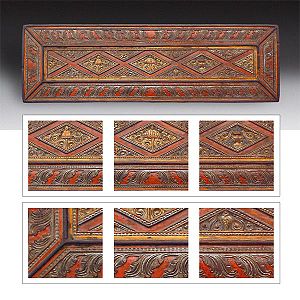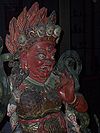
Tibetan art
Encyclopedia

Tibet
Tibet is a plateau region in Asia, north-east of the Himalayas. It is the traditional homeland of the Tibetan people as well as some other ethnic groups such as Monpas, Qiang, and Lhobas, and is now also inhabited by considerable numbers of Han and Hui people...
. For more than a thousand years, Tibetan artists have played a key role in the cultural life of Tibet
Tibet
Tibet is a plateau region in Asia, north-east of the Himalayas. It is the traditional homeland of the Tibetan people as well as some other ethnic groups such as Monpas, Qiang, and Lhobas, and is now also inhabited by considerable numbers of Han and Hui people...
. From designs for painted furniture to elaborate murals in religious buildings, their efforts have permeated virtually every facet of life on the Tibetan plateau
Tibetan Plateau
The Tibetan Plateau , also known as the Qinghai–Tibetan Plateau is a vast, elevated plateau in Central Asia covering most of the Tibet Autonomous Region and Qinghai, in addition to smaller portions of western Sichuan, southwestern Gansu, and northern Yunnan in Western China and Ladakh in...
. The vast majority of surviving artworks created before the mid-20th century are dedicated to the depiction of religious subjects, for the most part being distemper on cloth or murals. They were commissioned by religious establishments or by pious individuals for use within the practice of Tibetan Buddhism
Tibetan Buddhism
Tibetan Buddhism is the body of Buddhist religious doctrine and institutions characteristic of Tibet and certain regions of the Himalayas, including northern Nepal, Bhutan, and India . It is the state religion of Bhutan...
and were manufactured in large workshops by uncredited artists.
The art of Tibet may be studied in terms of influences which have contributed to it over the centuries, from other Chinese, Nepalese, Indian, and sacred
Sacred art
Sacred art is imagery intended to uplift the mind to the spiritual. Sacred art involves the ritual and cultic practices and practical and operative aspects of the path of the spiritual realization within the bosom of the tradition in question....
styles.
Mahayana Buddhist influence
As Mahayana Buddhism emerged as a separate school in the 4th century BC it emphasized the role of bodhisattvaBodhisattva
In Buddhism, a bodhisattva is either an enlightened existence or an enlightenment-being or, given the variant Sanskrit spelling satva rather than sattva, "heroic-minded one for enlightenment ." The Pali term has sometimes been translated as "wisdom-being," although in modern publications, and...
s, compassionate beings who forego their personal escape to Nirvana
Nirvana
Nirvāṇa ; ) is a central concept in Indian religions. In sramanic thought, it is the state of being free from suffering. In Hindu philosophy, it is the union with the Supreme being through moksha...
in order to assist others. From an early time various bodhisattvas were also subjects of statuary art. Tibetan Buddhism, as an offspring of Mahayana Buddhism, inherited this tradition. But the additional dominating presence of the Vajrayana
Vajrayana
Vajrayāna Buddhism is also known as Tantric Buddhism, Tantrayāna, Mantrayāna, Secret Mantra, Esoteric Buddhism and the Diamond Vehicle...
(or Buddhist tantra) may have had an overriding importance in the artistic culture. A common bodhisattva depicted in Tibetan art is the deity Chenrezig (Avalokitesvara), often portrayed as a thousand-armed saint with an eye in the middle of each hand, representing the all-seeing compassionate one who hears our requests. This deity can also be understood as a Yidam
Yidam
In Vajrayana Buddhism, an Ishta-deva or Ishta-devata is a fully enlightened being who is the focus of personal meditation, during a retreat or for life. The term is often translated into English as tutelary deity, meditation deity, or meditational deity...
, or 'meditation Buddha' for Vajrayana practice
Tantric influence

Vajrayana
Vajrayāna Buddhism is also known as Tantric Buddhism, Tantrayāna, Mantrayāna, Secret Mantra, Esoteric Buddhism and the Diamond Vehicle...
Buddhism for its common symbolism of the vajra, the diamond thunderbolt (known in Tibetan
Tibetan language
The Tibetan languages are a cluster of mutually-unintelligible Tibeto-Burman languages spoken primarily by Tibetan peoples who live across a wide area of eastern Central Asia bordering the Indian subcontinent, including the Tibetan Plateau and the northern Indian subcontinent in Baltistan, Ladakh,...
as the dorje). Most of the typical Tibetan Buddhist art can be seen as part of the practice of tantra. Vajrayana techniques incorporate many visualizations/imaginations during meditation, and most of the elaborate tantric art can be seen as aids to these visualizations; from representations of meditational deities (yidam
Yidam
In Vajrayana Buddhism, an Ishta-deva or Ishta-devata is a fully enlightened being who is the focus of personal meditation, during a retreat or for life. The term is often translated into English as tutelary deity, meditation deity, or meditational deity...
s) to mandala
Mandala
Maṇḍala is a Sanskrit word that means "circle". In the Buddhist and Hindu religious traditions their sacred art often takes a mandala form. The basic form of most Hindu and Buddhist mandalas is a square with four gates containing a circle with a center point...
s and all kinds of ritual implements.
A surprising aspect of Tantric Buddhism is the common representation of wrathful deities
Wrathful deities
In Buddhism, wrathful deities are enlightened beings who take on wrathful forms in order to lead sentient beings to enlightenment. They are a notable feature of the iconography of Mahayana Buddhism and of Tibetan Buddhism, and other Vajrayana traditions in particular. A wrathful deity is often an...
, often depicted with angry faces, circles of flame, or with the skulls of the dead. These images represent the Protectors (Skt
Sanskrit
Sanskrit , is a historical Indo-Aryan language and the primary liturgical language of Hinduism, Jainism and Buddhism.Buddhism: besides Pali, see Buddhist Hybrid Sanskrit Today, it is listed as one of the 22 scheduled languages of India and is an official language of the state of Uttarakhand...
. dharmapala
Dharmapala
In Vajrayana Buddhism, a dharmapāla is a type of wrathful deity. The name means "Dharma-defender" in Sanskrit, and the dharmapālas are also known as the Defenders of the Law , or the Protectors of the Law, in English....
) and their fearsome bearing belies their true compassionate nature. Actually their wrath represents their dedication to the protection of the dharma
Dharma
Dharma means Law or Natural Law and is a concept of central importance in Indian philosophy and religion. In the context of Hinduism, it refers to one's personal obligations, calling and duties, and a Hindu's dharma is affected by the person's age, caste, class, occupation, and gender...
teaching as well as to the protection of the specific tantric practices to prevent corruption or disruption of the practice. They are most importantly used as wrathful psychological aspects that can be used to conquer the negative attitudes of the practitioner.
Bön influence
The indigenous shamanistic religion of the Himalayas is known as Bön. Bon contributes a pantheon of local tutelary deities to Tibetan art. In Tibetan temples (known as lhakhang), statues of the Buddha or PadmasambhavaPadmasambhava
Padmasambhava ; Mongolian ловон Бадмажунай, lovon Badmajunai, , Means The Lotus-Born, was a sage guru from Oddiyāna who is said to have transmitted Vajrayana Buddhism to Bhutan and Tibet and neighbouring countries in the 8th century...
are often paired with statues of the tutelary deity of the district who often appears angry or dark. These gods once inflicted harm and sickness on the local citizens but after the arrival of Padmasambhava these negative forces have been subdued and now must serve Buddha.
See also
- Chorten
- Dzong architectureDzong architectureDzong architecture is a distinctive type of fortress architecture found in the present and former Buddhist kingdoms of the Himalayas: Bhutan and Tibet...
- Eight auspicious symbols
- Rubin Museum of ArtRubin Museum of Art__notoc__The Rubin Museum of Art is a museum dedicated to the collection, display, and preservation of the art of the Himalayas and surrounding regions, especially that of Tibet...
- SandpaintingSandpaintingSandpainting is the art of pouring colored sands, powdered pigments from minerals or crystals, and pigments from other natural or synthetic sources onto a surface to make a fixed, or unfixed sand painting...
- Tibetan rugTibetan rugTibetan rug making is an ancient, traditional craft. Tibetan rugs are traditionally made from Tibetan highland sheep's wool, called changpel. Tibetans use rugs for many purposes ranging from flooring to wall hanging to horse saddles, though the most common use is as a seating carpet...
s - Tibetan tsakliTibetan tsakliTsakli are Tibetan miniature paintings, normally produced as thematic groups or sets, which are used in rituals. Examples of this miniature art are also known from Mongolia...
Contemporary Tibetan art
Contemporary Tibetan art refers to the art of modern Tibet, or Tibet after 1950. It can also refer to art by the Tibetan diasporaTibetan diaspora
The Tibetan diaspora is a term used to refer to the communities of Tibetan people living outside Tibet. Tibetan emigration happened in two waves: one in 1959 following the 14th Dalai Lama's self-exile in India, and the other in the 1980s when Tibet was opened to trade and tourism. The third wave...
, which is explicitly political and religious in nature. Contemporary Tibetan art includes modern thangka
Thangka
A "Thangka," also known as "Tangka", "Thanka" or "Tanka" is a Tibetan silk painting with embroidery, usually depicting a Buddhist deity, famous scene, or mandala of some sort. The thankga is not a flat creation like an oil painting or acrylic painting...
(religious scroll paintings) that resemble ancient thangka, as well as radical, avant-garde
Avant-garde
Avant-garde means "advance guard" or "vanguard". The adjective form is used in English to refer to people or works that are experimental or innovative, particularly with respect to art, culture, and politics....
, works.
External links
- Museum exhibit of Tibetan art.
- Mechak Center for Contemporary Tibetan Art
- Peak Art Gallery, A Contemporary Tibetan Art Gallery
- Art of Tibet An online portal about eastern culture, art, the Dharma, and more.

